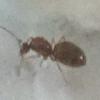Edited by Aquaexploder, June 8 2017 - 11:03 AM.
- Formiculture.com
- Forums
- Gallery
- Members
- Member Map
- Chat

Edited by Aquaexploder, June 8 2017 - 11:03 AM.
Antmaps.org would show a list of species in RI.
Edited by Aquaexploder, June 8 2017 - 11:22 AM.
The Myrmica queen you found was likely a mated queen that flew last year who did not have workers yet and was foraging for her brood .(they are semi-claustral)
The Myrmica queen you found was likely a mated queen that flew last year who did not have workers yet and was foraging for her brood .(they are semi-claustral)
If Nathant recommended Ellison et al.'s A Field Guide to the Ants of New England, that resource breaks down species occurrences by county in New England, so you'll be able to see if a species had been collected in whichever Rhode Island county you're interested in--prior to the book's publication, of course. The website antmaps.org, as Nathant suggested, is another excellent resource.
Both of these resources are based on existing museum collections and published accounts. Since insects don't recognize geographic boundaries, i.e., county and state lines, it's also important to take into account natural history due to holes in collections. For example, if a species you're interested in is listed on either side of your county, chances are it's probably also in your county, or if it occurs just on the other side of the border in Massachusetts, chances are it's also in Rhode Island. Since collections are location specific, there just isn't a specimen from that county in the collection. That said, it could also be a legitimate range boundary, but keep those things in mind.
0 members, 0 guests, 0 anonymous users